Genealogy
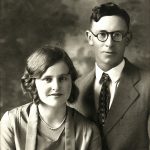
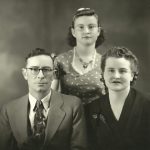 I often wonder, when thinking about couples and how they met, what might have happened if their families hadn’t moved to the state where they eventually met their spouse. Would they somehow have met in another way, like college, mutual acquaintances, or a random trip to the same city. It’s hard to say, I suppose, and the reality is that they may never have met at all. Thankfully, for my husband, Bob Schulenberg’s grandparents (and for me), his grandparents did end up in the same small town, and they did meet and married, producing Bob’s mom, Joann (Knox) Schulenberg, who gave birth to my husband. I say thankfully, of course, because if that hadn’t happened, I wouldn’t be married to my wonderful husband all these years.
I often wonder, when thinking about couples and how they met, what might have happened if their families hadn’t moved to the state where they eventually met their spouse. Would they somehow have met in another way, like college, mutual acquaintances, or a random trip to the same city. It’s hard to say, I suppose, and the reality is that they may never have met at all. Thankfully, for my husband, Bob Schulenberg’s grandparents (and for me), his grandparents did end up in the same small town, and they did meet and married, producing Bob’s mom, Joann (Knox) Schulenberg, who gave birth to my husband. I say thankfully, of course, because if that hadn’t happened, I wouldn’t be married to my wonderful husband all these years.
Grandpa, Robert Knox was born in Prosser, Washington, where his two brothers, Melburn Coe Knox and Joy Allen Knox, but on February 4, 1917, Joy Allen died 13 days after he was born on Jan 22, 1917, and by the time their next son, Richard Franklin “Frank” came along on February 4, 1920, the family was living in Rosebud, Montana. The birth of their Rainbow Baby, ironically on the same day as the death of their older son, must have been a little bit bittersweet. It seems like if the move was to get away from the memory of their loss, it actually ended up following them to the new place. All that aside, the family eventually moved to Rosebud, Montana.
Meanwhile, Grandma, Nettie (Noyes) Knox was born in Clyde Park, Montana, which was three hours and fifteen minutes from Rosebud, but the family would eventually move to Rosebud, Montana, which is, of course, where she met her future husband, Robert “Bob” Knox. They were married on June 14, 1928, in Miles City, Montana, 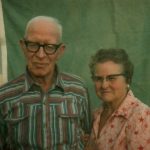
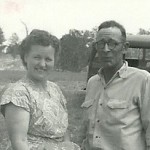 and as they say, the rest is history. While they lost their first child, a son named William Edgar Knox, at birth, they went on to have three daughters, Joann Schulenberg, Linda Cole, and Margee Kountz. They were married 57 years, until Grandpa went to heaven on December 17, 1985. Grandma lived until July 29, 1990, and then she joined him in Heaven. Today would have been their 95th anniversary. While there are no marriages in Heaven, I know Grandma and Grandpa are enjoying themselves as friends very much. Have a happy day, Grandma and Grandpa. We love and miss you very much.
and as they say, the rest is history. While they lost their first child, a son named William Edgar Knox, at birth, they went on to have three daughters, Joann Schulenberg, Linda Cole, and Margee Kountz. They were married 57 years, until Grandpa went to heaven on December 17, 1985. Grandma lived until July 29, 1990, and then she joined him in Heaven. Today would have been their 95th anniversary. While there are no marriages in Heaven, I know Grandma and Grandpa are enjoying themselves as friends very much. Have a happy day, Grandma and Grandpa. We love and miss you very much.
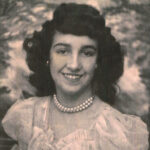
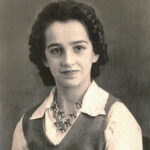 My aunt, Virginia Beadle was one of the sweetest, most kindhearted people I ever knew. She had a quiet voice that spoke volumes. It wasn’t that she spoke so softly that you couldn’t hear, although she did speak softly. Rather, it was the gentleness of her voice. I think that is what people mean when they say “soft-spoken.” A gentle voice that speaks volumes, and that is what Aunt Virginia had.
My aunt, Virginia Beadle was one of the sweetest, most kindhearted people I ever knew. She had a quiet voice that spoke volumes. It wasn’t that she spoke so softly that you couldn’t hear, although she did speak softly. Rather, it was the gentleness of her voice. I think that is what people mean when they say “soft-spoken.” A gentle voice that speaks volumes, and that is what Aunt Virginia had.
Aunt Virginia was an industrious person. She didn’t particularly care for housework and other domestic chores, and one time when her older sister, Evelyn Hushman was allowed to sleep in, because she had been babysitting the fussy baby all night, Aunt Virginia got the idea to ask, “So then if I have a job, you are saying that I won’t have to do housework either?” Well, Grandma Byer, her mom probably didn’t consider the ramifications of her answer, but she told her, “No, you wouldn’t.” With that weapon I. Her arsenal, Aunt Virginia went out and got a job. She had one from that time on, until her retirement. Of course, she also learned that when she got her own home, the “no more housework rule” would go out the window. As a child, you can sometimes get out of housework by getting a job, but when the house is yours and your kids are little, the housework is up to you. Nevertheless, Grandma, being a woman if her word, stood by the words she had spoken that day.
Aunt Virginia enjoyed her job over the years, and it gave her the opportunity to wear nice clothes and be around interesting people. I don’t know if she ever grew to like housework, but she was good at her jobs and she was a snappy dresser too. I was always very impressed by the way Aunt Virginia looked and how successful she was. I suppose everyone has different ideas about things. And for anyone who wants to be a stay-at-home mom, getting a 
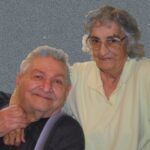 job might not be a great thing, but Aunt Virginia saw it as a way of escaping the housework she didn’t like, and no having her mom mad at her. The money she made also helped her to have the things she wanted, and saved Grandma and Grandpa from having to buy them. It was a win-win of sets, except that Grandma lost some of the housework help. Today would have been Aunt Virginia’s 93rd birthday. Happy birthday in Heaven, Aunt Virginia. We love and miss you very much.
job might not be a great thing, but Aunt Virginia saw it as a way of escaping the housework she didn’t like, and no having her mom mad at her. The money she made also helped her to have the things she wanted, and saved Grandma and Grandpa from having to buy them. It was a win-win of sets, except that Grandma lost some of the housework help. Today would have been Aunt Virginia’s 93rd birthday. Happy birthday in Heaven, Aunt Virginia. We love and miss you very much.
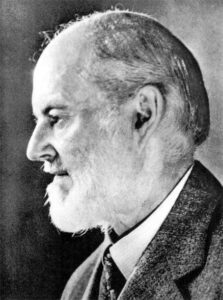 We have all heard of the Rolls Royce, and these days it is a car that is close to my heart, not because I own one, but because I’m pretty sure there are family ties to my son-in-law, Travis Royce and now, my daughter, Amy Royce, and their children, Shai and Caalab. I don’t know that for sure, but I have a hunch, and it’s not just the name. Time will tell as I research further.
We have all heard of the Rolls Royce, and these days it is a car that is close to my heart, not because I own one, but because I’m pretty sure there are family ties to my son-in-law, Travis Royce and now, my daughter, Amy Royce, and their children, Shai and Caalab. I don’t know that for sure, but I have a hunch, and it’s not just the name. Time will tell as I research further.
Sir Frederick Henry Royce, 1st Baronet, OBE, was an English engineer. OBE stands for “The Most Excellent Order of the British Empire and is a British order of chivalry, rewarding contributions to the arts and sciences, work with charitable and welfare organizations, and public service outside the civil service.” Sir Royce was famous for his designs of car and aeroplane engines with a reputation for reliability and longevity. Of course, we probably know much more about the product that brought him fame, than we do the man and his partners, who brought that product to life.
Sir Frederick Henry Royce was born in Alwalton, Huntingdonshire, near Peterborough on March 27, 1863, to James and Mary Royce (née King). He was youngest of their five children. His father ran a flour mill which he leased from the Ecclesiastical Commissioners. Unfortunately, the business failed, and the family moved to London. After his father died in 1872, Royce had to go out to work selling newspapers and delivering telegrams after only one year of formal schooling. With such a beginning, it would seem quite unlikely that Sir Royce would ever amount to anything, but in 1878 with the financial help of an aunt, Royce  was able to start an apprenticeship with the Great Northern Railway company at its works in Peterborough. Unfortunately, the money ran out after three years, and Royce was again forced to change careers. He worked for a short time with a tool-making company in Leeds, and then returned to London and joined the Electric Light and Power Company. In 1882, he moved to their Liverpool office and began working on street and theatre lighting.
was able to start an apprenticeship with the Great Northern Railway company at its works in Peterborough. Unfortunately, the money ran out after three years, and Royce was again forced to change careers. He worked for a short time with a tool-making company in Leeds, and then returned to London and joined the Electric Light and Power Company. In 1882, he moved to their Liverpool office and began working on street and theatre lighting.
Following a few other ventures that produced minimal success, Royce partnered with Charles Rolls (1877–1910) and Claude Johnson (1864–1926) and founded Rolls-Royce. The new company initially focused on large 40-50 horsepower motor cars, the Silver Ghost and its successors. Royce produced his first aero engine shortly after the outbreak of the First World War and aircraft engines became Rolls-Royce’s principal product. While the Rolls Royce aeroplane engine was a much-needed product during the war, it will always be the famous Rolls Royce automobiles that people will remember. They are beautifully elegant, and to be desired by those who have the means to afford them, as well as those who wish they could afford them.
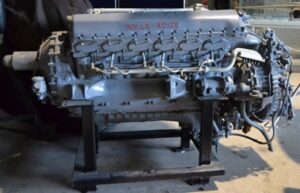
Henry Royce married Minnie Punt in 1893, but they had no children. The couple separated in 1912. Royce, who lived by the motto “Whatever is rightly done, however humble, is noble,” was appointed OBE in 1918, and was created a baronet, of Seaton in the County of Rutland, in 1930 for his services to British Aviation. Sir Royce’s health began to fail him in 1911 and he was finally forced to leave his factory in the Midlands at Derby. He took a team of designers and moved to the south of England, while spending winters in the south of France. He died at his home in Sussex on April 22, 1933. With no children, the baronetcy became extinct on his death.
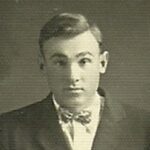
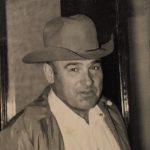 My husband’s grandfather, Andrew Carl Schulenberg was an interesting character. Born on March 12, 1906, to Max Heinrich Johann Carl Schulenberg and Julia Marie Doll. His dad was born in Oldenburg, Lower Saxony, Germany, and in those days, children were often given multiple middle names. I have always found that to be of interest, as I used to think that pretty much only royal children were given multiple middle names. It actually isn’t all that uncommon and many children today have multiple middle names. Max had immigrated to America by the time he met Julia, and they were married in Blair, Nebraska. Their oldest son, Andrew was born in Herman, Nebraska, as were his sisters Anna and Claudine. The rest of Andrew’s nine siblings were born in Forsyth, Montana.
My husband’s grandfather, Andrew Carl Schulenberg was an interesting character. Born on March 12, 1906, to Max Heinrich Johann Carl Schulenberg and Julia Marie Doll. His dad was born in Oldenburg, Lower Saxony, Germany, and in those days, children were often given multiple middle names. I have always found that to be of interest, as I used to think that pretty much only royal children were given multiple middle names. It actually isn’t all that uncommon and many children today have multiple middle names. Max had immigrated to America by the time he met Julia, and they were married in Blair, Nebraska. Their oldest son, Andrew was born in Herman, Nebraska, as were his sisters Anna and Claudine. The rest of Andrew’s nine siblings were born in Forsyth, Montana.
After a hunting accident took his right leg, Andy had a true peg leg for the rest of his life. Maybe it was the fact that he was only in his teens when it happened, or maybe it was just his own determined personality, but Andy did not let a “little thing” like an amputated leg turn him into an invalid. He went forward with his life…after about a year in the hospital, that is. And while he really didn’t like guns much after that, he was still capable of using one if needed. And actually, went on to become the sheriff of Rosebud County, Montana, and did it without a gun. I suppose it might have seemed a little bit like Sheriff Andy Taylor on the Andy Griffith Show, but I can’t say that Forsyth, or Rosebud County, was a tame as Mayberry was. Andy took it all in stride, worked with multiple agencies over his years as sheriff, and handled the Indian nation with mutual respect and grace. That was the reason they worked so well with him.
I first met Andy at a family reunion when my girls were about 6 and 5 years old. He was, of course their great 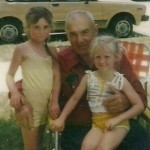
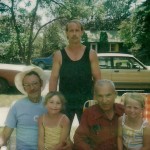 grandfather. And he seemed bigger than life. He was a tall…very tall man, but then I’m short, and maybe not a good judge of height. Still, I would guess 6 foot 3 inches, at last. His son, Uncle Butch Schulenberg could probably tell me for sure. Nevertheless, as big as he was, he took the time to build two small chairs for my girls, chairs they still love to this day. He was excited to meet them, and they were excited to meet him. I will always be glad we had that time with him. Today is the 117th anniversary of Grandpa Andy Schulenberg’s birth. Happy birthday in Heaven, Grandpa. We love and miss you very much.
grandfather. And he seemed bigger than life. He was a tall…very tall man, but then I’m short, and maybe not a good judge of height. Still, I would guess 6 foot 3 inches, at last. His son, Uncle Butch Schulenberg could probably tell me for sure. Nevertheless, as big as he was, he took the time to build two small chairs for my girls, chairs they still love to this day. He was excited to meet them, and they were excited to meet him. I will always be glad we had that time with him. Today is the 117th anniversary of Grandpa Andy Schulenberg’s birth. Happy birthday in Heaven, Grandpa. We love and miss you very much.
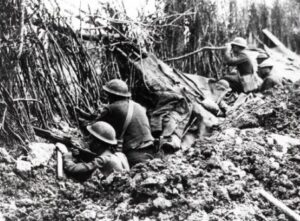
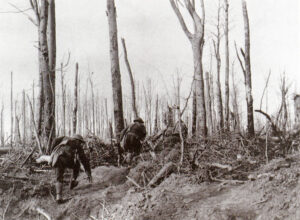 When I think of war and of the largest offensive in United States history, I don’t picture a battle in World War I. Nevertheless, I should. The Meuse–Argonne offensive, which was also called the Meuse River–Argonne Forest offensive, the Battles of the Meuse–Argonne, and the Meuse–Argonne campaign, depending on who you were, was a major part of the final Allied offensive of World War I that stretched along the entire Western Front. The offensive ran for a total of 47 days, from September 26, 1918, until the Armistice of November 11, 1918, and it was the largest in United States military history, past or present.
When I think of war and of the largest offensive in United States history, I don’t picture a battle in World War I. Nevertheless, I should. The Meuse–Argonne offensive, which was also called the Meuse River–Argonne Forest offensive, the Battles of the Meuse–Argonne, and the Meuse–Argonne campaign, depending on who you were, was a major part of the final Allied offensive of World War I that stretched along the entire Western Front. The offensive ran for a total of 47 days, from September 26, 1918, until the Armistice of November 11, 1918, and it was the largest in United States military history, past or present.
The offensive involved 1.2 million American soldiers, and as battles go, it is the second deadliest in American history. During the course of the battle, there were over 350,000 casualties including 28,000 German lives, 26,277 American lives, and an unknown number of French lives. The losses involving the United States were compounded by the inexperience of many of the troops, the tactics used during the early phases of the operation, and in no small way…the widespread onset of the global influenza outbreak called the “Spanish flu.” The 1918 Spanish Flu pandemic, also known as the Great Influenza epidemic, was an exceptionally deadly 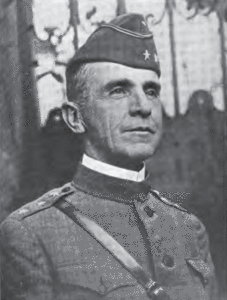
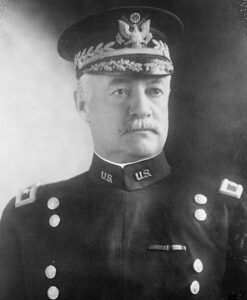 global influenza pandemic caused by the H1N1 influenza A virus. The pandemic affected an estimated 500 million people, or approximately a third of the global population. It is estimated that 17 to 50 million, and possibly as high as 100 million people lost their lives, which probably increased the deaths during the Meuse-Argonne offensive.
global influenza pandemic caused by the H1N1 influenza A virus. The pandemic affected an estimated 500 million people, or approximately a third of the global population. It is estimated that 17 to 50 million, and possibly as high as 100 million people lost their lives, which probably increased the deaths during the Meuse-Argonne offensive.
The Meuse–Argonne was the principal engagement of the American Expeditionary Force (AEF) during World War I, and it was what finally brought the war to an end. It was the largest and bloodiest operation of World War I for the AEF. Nevertheless, by October 31, the Americans had advanced 9.3 miles and had cleared the Argonne Forest. The French advanced 19 miles to the left of the Americans, reaching the Aisne River. The American forces split into two armies at this point. General Liggett led the First Army and advanced to the Carignan-Sedan-Mezieres Railroad. Lieutenant General Robert L Bullard led the Second Army and was directed to move eastward toward Metz. The two United States armies faced portions of 31 German divisions during this phase. The American troops captured German defenses at Buzancy, allowing French troops to cross the Aisne River. There, they rushed forward, capturing Le Chesne, also known as the Battle of Chesne (French: Bataille du Chesne).
In the final days, the French forces conquered the immediate objective, Sedan and its critical railroad hub in a 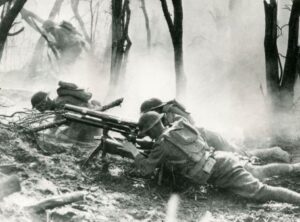
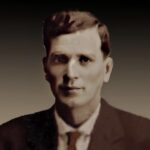
battle known as the Advance to the Meuse (French: Poussée vers la Meuse), and on November 6, American forces captured surrounding hills. On November 11, news of the German armistice put a sudden end to the fighting. That was fortunate for the armies, but for my 1st cousin twice removed, William Henry Davis, it was six days too late. He lost his life on November 5, 1918, on the west bank of the Meuse during these battles. He was just 30 years old at the time.

 With so much technology these days, the things that we used to do the old-fashioned way have begun to get lost in the annals of time. Some things, it seems to me would fall into the category of “good riddance,” while others fall into the category of “how sad.” I know that many people would disagree with me, but I have very little use for old-fashioned books. I know that is an odd one, but once you have read the book, how many people will go back and read it again…even the classics. Maybe a few people will, but with so many books to read, most will not. That is why e-books and audible books make perfect sense to me.
With so much technology these days, the things that we used to do the old-fashioned way have begun to get lost in the annals of time. Some things, it seems to me would fall into the category of “good riddance,” while others fall into the category of “how sad.” I know that many people would disagree with me, but I have very little use for old-fashioned books. I know that is an odd one, but once you have read the book, how many people will go back and read it again…even the classics. Maybe a few people will, but with so many books to read, most will not. That is why e-books and audible books make perfect sense to me.
A physical calendar is another thing that seems unnecessary to me, although I do like the pictures many of them have. The thing is that writing your schedule on a physical calendar is only helpful if you are where the calendar is. You might suggest a daily planner, but that still requires you to look at it periodically, and let’s face it. Time flies, especially during the workday. If you forget to look at that calendar, you miss your appointment.  The calendar on your phone, which as we all know is always with you, comes with a reminder that alerts you when it’s time to go to your appointment. Life is hectic, and I just don’t need the added stress of missing appointments, even now that I’m retired.
The calendar on your phone, which as we all know is always with you, comes with a reminder that alerts you when it’s time to go to your appointment. Life is hectic, and I just don’t need the added stress of missing appointments, even now that I’m retired.
I have gone shopping with a paper list, and I’m sure you have too. I have also gone to the store and forgotten my list. Then I spent my who shopping experience trying to remember what was on my list. I’ll be honest I don’t always shop with a list of any kind, but when I really need to remember something, a list is essential. Once again, I go back to my phone, because there is a note app on my phone, and you can even get an app specifically for groceries. That’s where I put the really important things, because I always have my phone with me…don’t you? You do, because really…nobody has a landline anymore.
While my dear uncle, Bill Spencer always wanted to get a letter from his loved ones, and I can totally understand why, after looking at some of the letters from my dad to his mom, from my uncle to me, and from ancestors I never met to other ancestors I never met. The point is, as my uncle put it that you can actually see their handwriting. That is truly a precious thing to have. I suppose that if I have one “old-fashioned” thing that 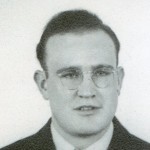
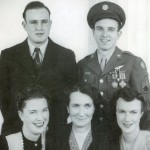
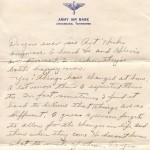 I could go both ways with letters would be that thing. Those handwritten letters are precious, but daily communication received quickly via text, messenger, or snap chat are very important to me too. When you have children who live far away, or as we all do, children who are very busy, those quick little messages are a great treasure. I think I will always treasure both.
I could go both ways with letters would be that thing. Those handwritten letters are precious, but daily communication received quickly via text, messenger, or snap chat are very important to me too. When you have children who live far away, or as we all do, children who are very busy, those quick little messages are a great treasure. I think I will always treasure both.

 We were watching the Denver Broncos in their huge (19-3) defeat of the Kansas City Chiefs. The game had really just gotten started (it had a 4:00pm start time) when the crash, that took the life of Diana, Princess of Wales, occurred in Paris at 12:23am (4:23pm Mountain Time). The news of the tragedy was aired shortly thereafter, and by 3:00am, Paris time, she was dead. That news was announced at 6:00am Paris time.
We were watching the Denver Broncos in their huge (19-3) defeat of the Kansas City Chiefs. The game had really just gotten started (it had a 4:00pm start time) when the crash, that took the life of Diana, Princess of Wales, occurred in Paris at 12:23am (4:23pm Mountain Time). The news of the tragedy was aired shortly thereafter, and by 3:00am, Paris time, she was dead. That news was announced at 6:00am Paris time.
Diana was a distant cousin of mine…(specifically my 12th cousin 2 times removed), so the news held some significance to my family. There have been many questions concerning the crash that took Diana’s life, and while the powers that be say that they have all been answered, there are many people, including me, who still have questions. I’m sure that we will never have our questions fully answered, and I’m sure that is partly due to the fact that when it comes to Diana, we aren’t sure that the British Crown is telling us everything they know. The mere fact that Prince Charles and Princess Diana were divorced, and at that time, and to many people, his claim to the throne was in question, we naturally doubted the validity of the answers we were given. Nevertheless, no further answers will likely be forthcoming, so we will have to accept the answers we were given…or not accept them, as you please. After the divorce, Princess Diana became known as Diana, Princess of Wales, as a supposed concession by the crown.
Diana, affectionately known as “the People’s Princess,” was 36 years old at the time of her death. Her  boyfriend, the Egyptian-born socialite Dodi Fayed, and the driver of the car, Henri Paul, died as well. The lone survivor of the crash was Diana’s bodyguard Trevor Rees-Jones, who was seriously injured. The car left the Ritz Paris just after midnight, intending to go to Dodi’s apartment on the Rue Arsène Houssaye. As soon as they departed the hotel, a swarm of paparazzi on motorcycles began aggressively tailing their car. About three minutes later, the driver lost control and crashed into a pillar at the entrance of the Pont de l’Alma tunnel. It was later decided that because the driver had alcohol and prescription drugs in his system, the paparazzi held no fault in the matter. That is where I disagree. While the driver had alcohol and prescription drugs in his system, he would not have felt the need to speed through the streets if the paparazzi had left them alone. As a retired insurance agent, I know contributory negligence when I see it. Nevertheless, a “formal investigation” concluded the paparazzi did not cause the collision. Dodi Fayed and Henri Paul, the driver, were pronounced dead at the scene. Diana was taken to the Pitié-Salpêtrière hospital and officially declared dead at 6:00am. Diana’s former husband Prince Charles, as well as her sisters and other members of the Royal Family, arrived in Paris that morning. Diana’s body was then taken back to London.
boyfriend, the Egyptian-born socialite Dodi Fayed, and the driver of the car, Henri Paul, died as well. The lone survivor of the crash was Diana’s bodyguard Trevor Rees-Jones, who was seriously injured. The car left the Ritz Paris just after midnight, intending to go to Dodi’s apartment on the Rue Arsène Houssaye. As soon as they departed the hotel, a swarm of paparazzi on motorcycles began aggressively tailing their car. About three minutes later, the driver lost control and crashed into a pillar at the entrance of the Pont de l’Alma tunnel. It was later decided that because the driver had alcohol and prescription drugs in his system, the paparazzi held no fault in the matter. That is where I disagree. While the driver had alcohol and prescription drugs in his system, he would not have felt the need to speed through the streets if the paparazzi had left them alone. As a retired insurance agent, I know contributory negligence when I see it. Nevertheless, a “formal investigation” concluded the paparazzi did not cause the collision. Dodi Fayed and Henri Paul, the driver, were pronounced dead at the scene. Diana was taken to the Pitié-Salpêtrière hospital and officially declared dead at 6:00am. Diana’s former husband Prince Charles, as well as her sisters and other members of the Royal Family, arrived in Paris that morning. Diana’s body was then taken back to London.
Because Diana was one of the most popular public figures in the world, her death brought a massive outpouring of grief. Mourners began leaving bouquets of flowers at Kensington Palace immediately. The piles of flowers reached about 30 feet from the palace gate. As in her life, her death demanded the attention of the world. She was so loved, and many felt, so mistreated during her marriage. Following her funeral on September 6, 1997, an event that was watched by 2.5 billion people, she was laid to rest on an island at Althorp Estate, which is her childhood home, and is which is where her brother, Earl Charles Spencer lives to this day. The island is off limits, but the estate is open to the public during July and August each year.
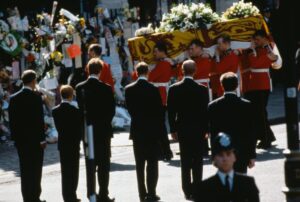
 Diana was survived by her two sons, Prince William, who was 15 at the time, and Prince Harry, who was 12. Today she has two daughters-in-law, Duchess Catherine and Duchess Meaghan, as well as five grandchildren, Prince George, Princess Charlotte, Prince Louis; as well as; Archie and Lillibet. Today marks 25 years since the passing of Princess Diana. Gone but not forgotten.
Diana was survived by her two sons, Prince William, who was 15 at the time, and Prince Harry, who was 12. Today she has two daughters-in-law, Duchess Catherine and Duchess Meaghan, as well as five grandchildren, Prince George, Princess Charlotte, Prince Louis; as well as; Archie and Lillibet. Today marks 25 years since the passing of Princess Diana. Gone but not forgotten.
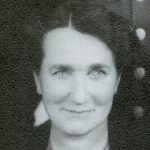
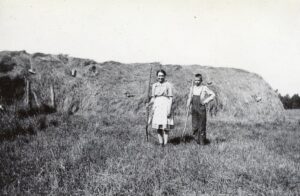 My dad’s mom, Anna Spencer was such a strong woman. My grandfather, Allen Spencer worked on the Great Northern Railway, and so Grandma was in charge of the kids, including her two rambunctious boys, my Uncle Bill and my dad, Allen. Now that doesn’t say that her two girls weren’t a handful too, but my Aunt Laura and my Aunt Ruth, likely caused her a little bit less trouble than her mischievous boys…especially when it came to their use of dynamite. Being farm boys, they used dynamite to remove tree stumps, for their wake-up call on Independence Day, as well as the occasional gatepost (which then had to be raised two inches before their mom came home from town). Nevertheless, Grandma was loved and respected by her children.
My dad’s mom, Anna Spencer was such a strong woman. My grandfather, Allen Spencer worked on the Great Northern Railway, and so Grandma was in charge of the kids, including her two rambunctious boys, my Uncle Bill and my dad, Allen. Now that doesn’t say that her two girls weren’t a handful too, but my Aunt Laura and my Aunt Ruth, likely caused her a little bit less trouble than her mischievous boys…especially when it came to their use of dynamite. Being farm boys, they used dynamite to remove tree stumps, for their wake-up call on Independence Day, as well as the occasional gatepost (which then had to be raised two inches before their mom came home from town). Nevertheless, Grandma was loved and respected by her children.
Grandma and the kids ran the farm, and that meant putting the hay up into stacks by hand, taking care of the animals and the garden. When they were working, Grandma was all business, but that didn’t mean the kids followed suit. My Aunt Ruth loved horses and dogs too, and goofing off for my Uncle Bill, so he could take a picture of her. Somehow, it once caught my grandma in the picture looking at her mischievous children, goofing off instead of working. Somehow, she was not very amused, but while Grandma didn’t think it was funny, the picture is one that always makes me laugh. I don’t know if my Aunt Ruth got in trouble for “shirking” her responsibilities or not, but I’ll bet she at least heard about it. Grandma was not really a pushover, after all. In those days, when it was time to work, the kids had better toe the line.
During the time when my grandma was raising kids, the country was going through the Great Depression years, and time were tough anyway, so the people also had to be tough. The men were often working somewhere also, and the women had to take on the role of both parents, and even businesswomen. My grandmother ran a hotel for a time, and my Aunt Laura, who was just ten years old when my Uncle Bill was 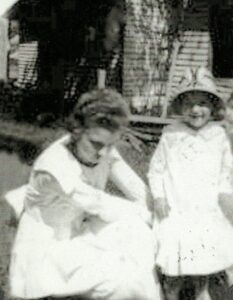
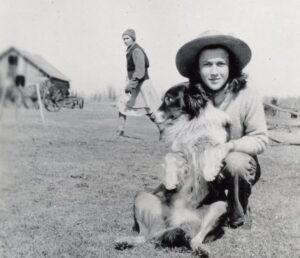 born, was responsible for his day-to-day care. My Uncle Bill actually remembered that time fondly. He and his big sister were very close at that time. I’m sure it was not the ideal situation for my grandmother, who must have felt like she was missing out on the baby years, but she persevered, and the family did well. Grandma was a tough lady, because she had to be, and the family needed her to be. I’m very proud of the strong woman she was. Today, Grandma is in Heaven, but this is the 135th anniversary of that great lady’s birth. Happy birthday in Heaven, Grandma. We love and miss you very much.
born, was responsible for his day-to-day care. My Uncle Bill actually remembered that time fondly. He and his big sister were very close at that time. I’m sure it was not the ideal situation for my grandmother, who must have felt like she was missing out on the baby years, but she persevered, and the family did well. Grandma was a tough lady, because she had to be, and the family needed her to be. I’m very proud of the strong woman she was. Today, Grandma is in Heaven, but this is the 135th anniversary of that great lady’s birth. Happy birthday in Heaven, Grandma. We love and miss you very much.

 My husband, Bob Schulenberg’s grandmother, Nettie Knox was a sweet woman. She really didn’t like drama, but rather preferred that life would flow along like a peaceful river. Grandma had a houseful of plants, including a Christmas Cactus that took up about a fourth of her small living room. I guess it was a good thing that it was just Grandma and Grandpa sitting in there most of the time. They lived on the same country property as Bob’s parents, so most of the visiting took place at the bigger family home of my in-laws. The living situation worked out very well. Grandpa had his tons of books, and he read them all at the same time…oddly enough. Grandma had her plants and her cooking.
My husband, Bob Schulenberg’s grandmother, Nettie Knox was a sweet woman. She really didn’t like drama, but rather preferred that life would flow along like a peaceful river. Grandma had a houseful of plants, including a Christmas Cactus that took up about a fourth of her small living room. I guess it was a good thing that it was just Grandma and Grandpa sitting in there most of the time. They lived on the same country property as Bob’s parents, so most of the visiting took place at the bigger family home of my in-laws. The living situation worked out very well. Grandpa had his tons of books, and he read them all at the same time…oddly enough. Grandma had her plants and her cooking.
Grandma and my oldest daughter, Corrie Petersen share a birthday. I know that there are people who wouldn’t like that, because they want their child to have their own day, but for Grandma and Corrie, it was just the opposite. They loved that they shared a birthday. It was their special bond. Their birthday parties were always together, and they always took together birthday pictures. They were birthday twins, and they loved it. Corrie had her birthday twin with her for the first 15 years of her life, and she considered it to be very sad when that first birthday without her birthday twin came along. It felt a little empty, and definitely sad.
Grandma Knox left us on July 29, 1990, almost 32 years ago now. That is such a strange thought, because it 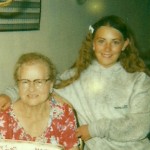
 seems like just yesterday that she and “little” Corrie were posing for their special picture. Grandma has lived on for five years after Granda went to Heaven, and while she wanted to stay with us, she also wanted to go home to Heaven. She was tired, and she wanted to be with Grandpa, so on July 29, 1990, she went home. I know she and Grandpa are having a great time celebrating her day today. Grandma, your special little birthday twin still misses you every day. Today, Grandma would be 114 years old. Happy birthday in Heaven, Grandma Knox. We all love and miss you very much.
seems like just yesterday that she and “little” Corrie were posing for their special picture. Grandma has lived on for five years after Granda went to Heaven, and while she wanted to stay with us, she also wanted to go home to Heaven. She was tired, and she wanted to be with Grandpa, so on July 29, 1990, she went home. I know she and Grandpa are having a great time celebrating her day today. Grandma, your special little birthday twin still misses you every day. Today, Grandma would be 114 years old. Happy birthday in Heaven, Grandma Knox. We all love and miss you very much.
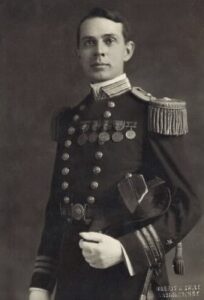 The United States Navy ship USS Knox (FF-1052) was named for Commodore Dudley Wright Knox, who was an officer in the United States Navy during the Spanish-American War and World War I. Born in Fort Walla Walla, Washington, on June 21, 1877, Knox was also a prominent naval historian. For many years he oversaw the Navy Department’s historical office, now called the Naval Historical Center. I can’t say for sure, nor exactly how, but I suspect that Dudley Wright Knox is somehow related to my husband, Bob Schulenberg’s Knox side of the family. That will be a subject I will need to explore further in the future.
The United States Navy ship USS Knox (FF-1052) was named for Commodore Dudley Wright Knox, who was an officer in the United States Navy during the Spanish-American War and World War I. Born in Fort Walla Walla, Washington, on June 21, 1877, Knox was also a prominent naval historian. For many years he oversaw the Navy Department’s historical office, now called the Naval Historical Center. I can’t say for sure, nor exactly how, but I suspect that Dudley Wright Knox is somehow related to my husband, Bob Schulenberg’s Knox side of the family. That will be a subject I will need to explore further in the future.
Knox attended school in Washington DC and graduated from the United States Naval Academy on June 5, 1896. Following his graduation, he served in the Spanish-American War aboard the screw steamer Maple in Cuban waters. A screw steamer or screw steamship is an old term for a steamship or steamboat powered by a steam engine, using one or more propellers…also known as screws…to propel it through the water. These ships were nicknamed iron screw steam ship.
His was a long and distinguished career. During the Philippine-American War, Knox commanded the gunboat Albay, and during the Chinese Boxer Rebellion, the gunboat Iris. He then commanded three of the Navy’s first destroyers…Shubrick, Wilkes, and Decatur. Following his attendance and graduation from the Naval War College in 1912–13, Knox became the aide to Captain William Sims, commanding the Atlantic Torpedo Flotilla. During the cruise of the “Great White Fleet,” he was sent around the world by President Theodore Roosevelt, as an ordnance officer on the battleship Nebraska (BB-14).
He took the lead in developing naval operational doctrine when he published an article of great influence in the US Naval Institute Proceedings in 1915. He was Fleet Ordnance Officer in both the Atlantic and the Pacific, serving in the Office of Naval Intelligence, and commanding the Guantanamo Bay Naval Station. The job of a Fleet Ordnance Officers is to ensure that weapons systems, vehicles, and equipment are ready and available…and in perfect working order, at all times. These officers also manage the developing, testing, fielding, handling, storage, and disposal of munitions. In November 1917, Knox joined the staff of, by then, Admiral William Sims, Commander of US Naval Forces in European Waters. Knox earned the Navy Cross for “distinguished service” while serving as Aide in the Planning Section and later in the Historical Section. He was promoted to Captain on 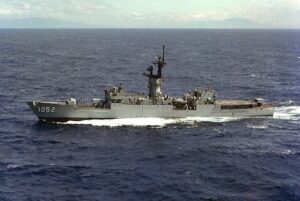 February 1, 1918. In March 1919, Knox returned to the United States. He served for a year on the faculty of the Naval War College, where he was a key figure on the Knox-King-Pye Board that examined professional military education. In 1920–21, he commanded the armored cruiser Brooklyn (ACR-3), then the protected cruiser Charleston (C-22) before resuming duty in the Office of the Chief of Naval Operations.
February 1, 1918. In March 1919, Knox returned to the United States. He served for a year on the faculty of the Naval War College, where he was a key figure on the Knox-King-Pye Board that examined professional military education. In 1920–21, he commanded the armored cruiser Brooklyn (ACR-3), then the protected cruiser Charleston (C-22) before resuming duty in the Office of the Chief of Naval Operations.
Also in 1920, Knox first began his work as a naval publicist, serving as naval editor of the Army and Navy Journal until 1923. He then became the naval correspondent of the Baltimore Sun in 1924 – 1946, and naval correspondent of the New York Herald Tribune in 1929. While he was transferred to the Retired List of the Navy on October 20, 1921, he actually and strangely continued on active duty, serving simultaneously as Officer in Charge, Office of Naval Records and Library, and as Curator for the Navy Department. Knox played a key role in creating the Naval Historical Foundation. Early in World War II, he was assigned additional duty as Deputy Director of Naval History.
In a career that spanned half of a century, Knox’s leadership inspired diligence, efficiency, and initiative while he guided, improved, and expanded the Navy’s archival and historical operations. Knox had personal connections to President Roosevelt, Fleet Admiral Ernest J King, and other senior leaders in the Navy Department. These relationships allowed him to play an instrumental role, albeit behind the scenes in the years leading up to and during World War II.
Knox published a number of writings and several books…including his first book “The Eclipse of American Sea Power” (1922) and “A History of the United States Navy” (1936). “A History of the United States Navy” is recognized as “the best one-volume history of the United States Navy in existence.” Through his personal connection with President Roosevelt, he was able to publish key, multi-volume collections of documents on 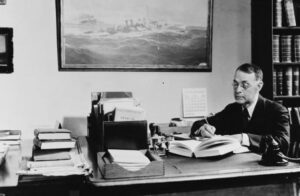 naval operations in The Quasi-War with France in 1798–1800, the first Barbary war and the second Barbary War…stories that may not have been told, had he not taken the initiative.
naval operations in The Quasi-War with France in 1798–1800, the first Barbary war and the second Barbary War…stories that may not have been told, had he not taken the initiative.
November 2, 1945, found Knox promoted to Commodore, and awarded the Legion of Merit for “exceptionally meritorious conduct” while directing the correlation and preservation of accurate records of the US naval operations in World War II, thus protecting this vital information for posterity. Finally, on June 26, 1946, Knox was relieved of all active-duty work. He died in Bethesda, Maryland, on June 11, 1960. His cause of death is listed as unknown. He was 83 years old.

